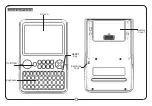
12
Battery Charging Tips
Warning
Batteries produce combustible gases that can explode! Always read and follow the instructions given
by the battery manufacturer’s label and on the battery charging device. Always wear proper safety
equipment (Safety Goggles, Rubber Gloves, etc…) when handling and charging batteries.
Why charge batteries?
Batteries are not 100% efficient; you need to replenish about 115% of the electricity you use. There
are several ways to recharge deep cycle batteries: battery chargers, engine alternators, solar panels,
wind or water generators, auxiliary generators, inverter/chargers, etc. Regardless of the method(s)
you use, your batteries will last longer and work better if they are charged properly.
What do batteries want?
Batteries should be charged in a controlled way. The chemical processes and physical constraints of
batteries dictate that they be charged in distinct phases, rather than in a single phase as with archaic
charging systems and simple regulators.
Marine deep-cycle batteries will last the longest and
charge the fastest if they are properly charged.
This can save you more than the cost of an
effective charging device.
This makes it difficult to recommend precise charging voltages, since they vary according to the
temperature of the battery. Higher temperatures require lower voltages, and lower temperatures
require higher voltages.
Equalization
An optional (and frequently omitted ) stage of battery care is equalization. It is used to prevent
flooded lead acid batteries from aging prematurely. After the battery reaches the end of acceptance
phase, the battery continues to be charged until the voltage stops rising – usually around 15.5-16.2
volts. This forces the battery to its highest possible state of charge, and dissolves the crystals of lead
sulfate which have collected on the battery’s plates. In applications where maximum energy storage
is important, this phase is done every charge cycle. In the marine environment, it is more likely to be
done every 20-50 cycles, which will extend the life and capacity of wet batteries. Since electrical
equipment and light-bulb filaments can be damaged by high voltage, the battery should be
disconnected from all loads during equalization.
This type of battery charging, consisting of multiple stages, is not possible with automotive-type
regulators, unregulated solar panels, ferroresonant chargers, or taffrail generators. We strongly
encourage the use of efficient charge devices that use modern multiple-step regulation.
Summary of Contents for DYNA-FOG DYNA-JET L30 2 Series
Page 21: ... ...
Page 22: ...Terminal Strip Wire Connection Diagram 22 ...
Page 24: ......
Page 26: ... ...
Page 28: ...28 ...
Page 30: ...Pump Bracket Assembly L30 30 ...
Page 38: ......
Page 41: ...Pump Enclosure Wiring Diagram L30 41 ...
Page 42: ...Remote Control Box Schematic L30 Series 2 42 ...













































